In the first of our series on the newly opened Hong Kong Palace Museum, Tracey Furniss dwells on the building’s remarkable architecture, which resonates with the features of the museum’s Beijing prototype while reflecting a modern, forward-looking spirit.
 The Hong Kong Palace Museum building subtly references traditional Chinese objects, like a bronze tripod, while exuding a futuristic vibe. (PHOTO PROVIDED TO CHINA DAILY)
The Hong Kong Palace Museum building subtly references traditional Chinese objects, like a bronze tripod, while exuding a futuristic vibe. (PHOTO PROVIDED TO CHINA DAILY)
The architecture and landscaping of the Hong Kong Palace Museum (HKPM), which opened to the public on Sunday, is nothing if not spectacular. Conceived as a franchise of Beijing’s Forbidden City Palace Museum, with the aim of fostering an appreciation of Chinese art and culture internationally, the HKPM has been designed by Hong Kong’s Rocco Design Architects Associates.
“I was inspired by traditional Chinese culture. Like all buildings that I have designed in China, including Hong Kong, the city is my main inspiration,” says Rocco Yim, executive director of the eponymous architecture practice.
Heralded as Chinese culture’s window on the world, the HKPM is poised majestically at the western tip of the West Kowloon Cultural District (WKCD) on the Victoria Harbour waterfront. The shape is reminiscent of traditional Chinese objects, yet the overall look is contemporary and sits well alongside Hong Kong’s ultramodern architecture. While the HKPM is meant to function as a “sister” museum to Beijing’s Palace Museum, Yim emphasizes that he was inspired by Chinese tradition but not enslaved by it.
 The Rocco Design Architects Associates-created facade of the Hong Kong Palace Museum comprises 4,022 pieces of decorative aluminum panels. (PHOTO PROVIDED TO CHINA DAILY)
The Rocco Design Architects Associates-created facade of the Hong Kong Palace Museum comprises 4,022 pieces of decorative aluminum panels. (PHOTO PROVIDED TO CHINA DAILY)
“Because this is not the Beijing museum, which was in itself a contemporary piece of architecture 600 years ago — a product of the lifestyle and the geography of those times,” says Yim. “The building in Hong Kong is not going to be a heritage building for another 200 or 300 years, but at the moment it needs to be a piece of contemporary architecture which reflects the cultures of our time. So this building is part of a city and a piece of the jigsaw that has to fit perfectly with the original thinking behind WKCD.”
Yim says the architectural resonances between the two museums in Beijing and Hong Kong are more metaphysical than physical. These are reflected in the building’s poise and sophistication of craftsmanship.
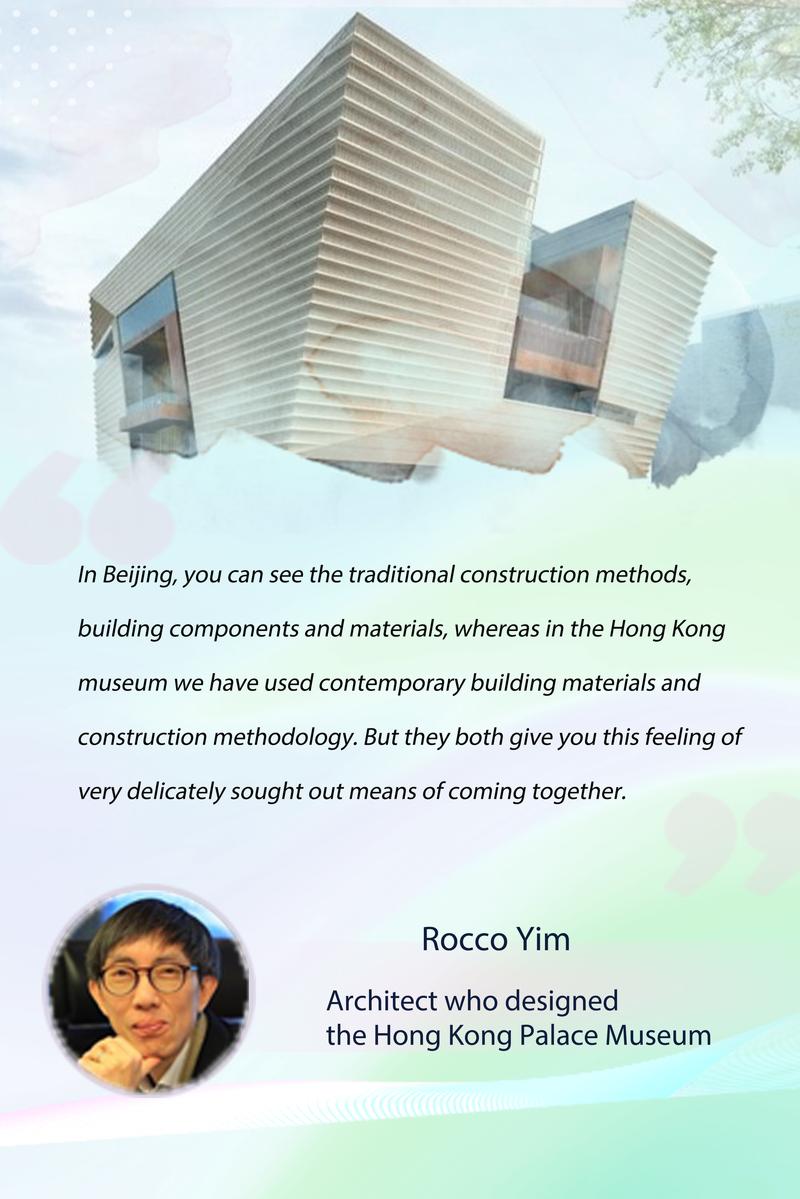
“In Beijing, you can see the traditional construction methods, building components and materials, whereas in the Hong Kong museum we have used contemporary building materials and construction methodology. But they both give you this feeling of very delicately sought out means of coming together. This sophistication of the craft in HKPM is conveyed in a contemporary sense.”
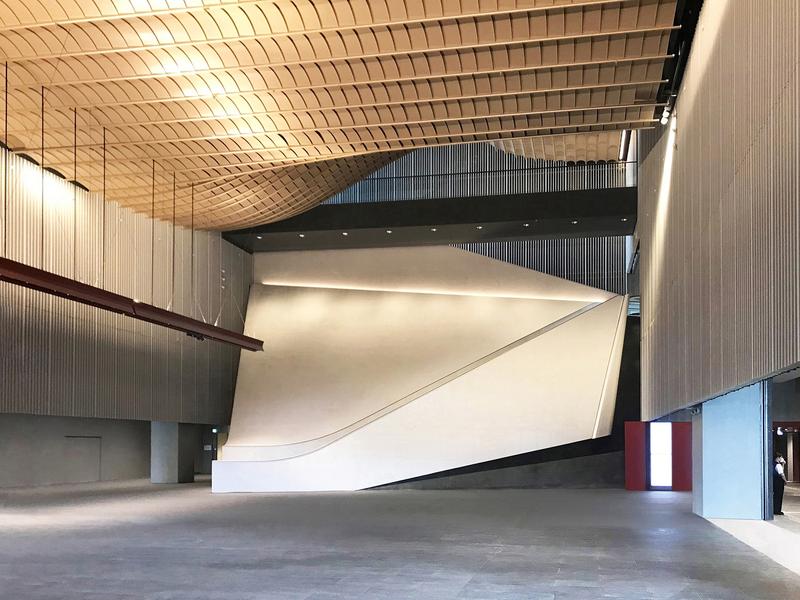 The design for HKPM’s interior ceiling is inspired by the paging panel-style layered porcelain tiles on the roof of the Forbidden City Palace Museum. (PHOTO PROVIDED TO CHINA DAILY)
The design for HKPM’s interior ceiling is inspired by the paging panel-style layered porcelain tiles on the roof of the Forbidden City Palace Museum. (PHOTO PROVIDED TO CHINA DAILY)
Standing tall
Both sites are vast. While Beijing’s Palace Museum is built along a horizontal axis, Hong Kong’s 30,000-square-meter museum space, with its nine galleries, 400-seat auditorium, activity rooms and so on, fans out vertically over seven floors. The building expands as one climbs upwards.
“When you go to the Beijing Palace Museum and enter the front gate, you don’t see everything at once,” says Yim. “You have to go through one courtyard after another before you can discover the whole complex. In traditional Chinese architecture, the organization of negative spaces are the courtyards, arranged in such a way that you are prompted to explore (the rooms around them).”
His design of the vertical HKPM is driven by a similar idea. “This layering of space, in order to create an incentive for people to move forward, is the common strategy that we share.”
Yim also adopted the main colors of the Beijing Palace Museum — red, yellow and blue — but toned down the bright yellow of the roof tiles to “a more grayish bronze” for the Hong Kong edition. “Because in Beijing, 600 years ago, everything around you was gray,” and the bright yellow roof tiles atop the structure that served as the centerpiece of the city added a splash of color to the skyline — not a requirement in today’s Hong Kong.
Another Beijing-inspired feature appears in the HKPM’s gorgeous ceiling. Yim wanted to remind HKPM visitors of the paging panel-style layered arrangement of porcelain tiles on the Beijing Palace Museum’s roof — “the most defining element of the architecture, for me”. He re-created the idea in Hong Kong by bringing the concept indoors.
The HKPM ceiling “starts off as a metaphor of the plates on the Beijing Palace museum roof,” says Yim, but its flowing, sinuous lines with their twists and turns “lead people upwards visually and connect to different areas. It becomes almost like a fabric. When it reaches the top beneath the skylight, it becomes a veil that also diffuses the sunlight, so it’s both functional and visual.”
 A gallery dedicated to prized objects loaned from the Forbidden City is done up in red. (PHOTO PROVIDED TO CHINA DAILY)
A gallery dedicated to prized objects loaned from the Forbidden City is done up in red. (PHOTO PROVIDED TO CHINA DAILY)
Nod to tradition
Translating traditional features into a modern context has connected the building to its function and surrounds. The HKPM building is a contemporary piece of architecture that oozes Chinese tradition in its colors and shapes. It reflects local Chinese culture while respecting Beijing’s traditional past.
Johnson Chang, founding director of Hong Kong’s Hanart TZ gallery, feels that the shape of the HKPM building embraces the spirit of the bronze tripod.
“Historically, the tripod resided at places that held political authority, and the offering of a tripod to a feudal state in (the) pre-Qin era meant granting legitimate political power to that state,” he says. “Therefore I believe establishing the (Hong Kong) Palace Museum here is a subtle and appropriate symbol representing the ‘one country two systems’ that Beijing continues to stress.”
From the outset, the HKPM’s director, Louis Ng Chi-wa, was keen to have the building’s interior design resonate with the diversity of treasures on display.
“As a part-time university professor for many years, I had taught about synergy and how to build a museum in the 21st century for certain kinds of museum pieces,” says Ng. The top job at the HKPM gives him a chance to put theory into practice.
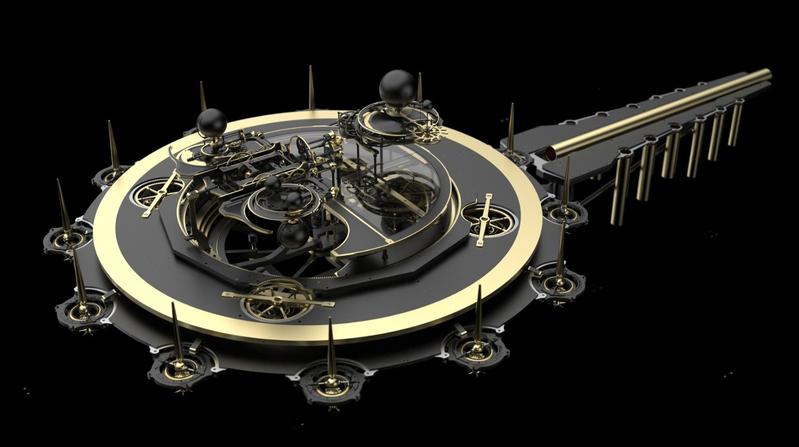 The one for displaying works by local multimedia artists comes with a dark background. Each of the HKPM’s nine exhibition galleries is distinguished by color. (PHOTO PROVIDED TO CHINA DAILY)
The one for displaying works by local multimedia artists comes with a dark background. Each of the HKPM’s nine exhibition galleries is distinguished by color. (PHOTO PROVIDED TO CHINA DAILY)
Every turn a surprise
Ng explains how each museum gallery has a distinct look and feel. The entire show has been designed in a way that Ng believes will keep visitors motivated to see more. For example, the ceramics gallery is done in white to highlight the colors and beauty of the artifacts on display, whereas some of the more contemporary pieces are displayed in a black surrounding to make them pop. The color scheme of the museum’s interiors might appeal particularly to the youngsters, the museum director feels. “I think it will keep their minds alert because the gallery spaces are not just white; you have these dramatic color changes.”
“The museum looks just like a small box compared with neighboring M+ but when visitors go inside HKPM, wow! There are a lot of things to see. Even if you spend two or three hours, there is a lot of space to explore — the experience is extraordinary,” Ng continues.
Galleries 1 and 2 focus on artifacts from the Forbidden City. Gallery 3 houses the imperial collection of Chinese ceramics. Multimedia technology is installed in Gallery 4, and 5, where visitors can learn about and have interactive experiences involving ancient crafts. Chinese art from private and public collections in Hong Kong are displayed in Gallery 6. Gallery 7 houses contemporary art from local Hong Kong artists. Gallery 8 showcases Chinese paintings and calligraphy from the Beijing Palace Museum, and Gallery 9 is for displaying art with similar themes from China and elsewhere. The current exhibition highlights the depiction of horses in ancient Chinese art, displayed alongside horse-themed paintings and sculptures loaned from the Louvre in Paris.
“I have seen the inside of the building which is very beautiful and caters to professional requirements of a historical museum. It also provides for the display of digital and contemporary art, which is the direction in which all new museums are moving,” says Chang. “All in all, I find HKPM a most optimistic and exciting project.”
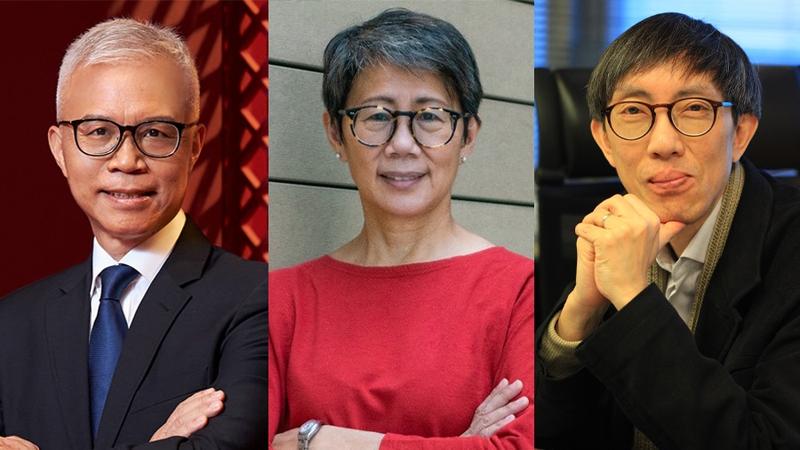 (From left) Hong Kong Palace Museum Director Louis Ng Chi-wa says the building’s layout and color scheme are likely to trigger a spirit of discovery in the visitors; Former LegCo member and academic Christine Loh Kung-wai says the onus is on the West Kowloon Cultural District to ensure the HKPM’s designed-in capabilities are maximized; Rocco Yim, who designed the building, says, while paying homage to its Beijing predecessor, the Hong Kong Palace Museum’s architecture is also about reflecting the cultures of the time and city it is located in. (PHOTOS PROVIDED TO CHINA DAILY)
(From left) Hong Kong Palace Museum Director Louis Ng Chi-wa says the building’s layout and color scheme are likely to trigger a spirit of discovery in the visitors; Former LegCo member and academic Christine Loh Kung-wai says the onus is on the West Kowloon Cultural District to ensure the HKPM’s designed-in capabilities are maximized; Rocco Yim, who designed the building, says, while paying homage to its Beijing predecessor, the Hong Kong Palace Museum’s architecture is also about reflecting the cultures of the time and city it is located in. (PHOTOS PROVIDED TO CHINA DAILY)
Sustainability issues
The WKCD has attracted controversies since almost as soon as the local government started inviting proposals for the district’s development in the early 2000s. Environmentalists have questioned the use of reclaimed land to build museums.
Christine Loh Kung-wai, chief development strategist at the Hong Kong University of Science and Technology and former undersecretary for the environment in the HKSAR government, has watched the scene from up close.
“There were discussions about whether West Kowloon should be reclaimed. Then there was discussion about what should the land be used for and there were long years of debate about how to finance a cultural district,” says Loh.
“The government proposed using property to finance culture, and the initial plan was to ask property developers to propose how they would do it. One of the design ideas was that there would be a massive domelike structure to cover the entire district. There was objection to this as a concept — it would waste energy. In the end, the whole process had to start again, which was why WKCD took so many years to build.”
She says it is up to the WKCD to ensure they manage the site as sustainably as possible. “This means you have to look at the design structure of each of the buildings to see the extent of their green elements and how they should be managed to maximize the designed-in capabilities.”
It is important to remain vigilant as to whether a building is being operated to its designed-in capabilities once it becomes functional, Loh adds. A building needs to be maintained well, and over time, parts will need to be retrofitted.
The HKPM design incorporates several sustainable features. For example, it has a wider top with a smaller base, primarily because Yim wanted to preserve as much open and green space as possible at the ground level for public use.
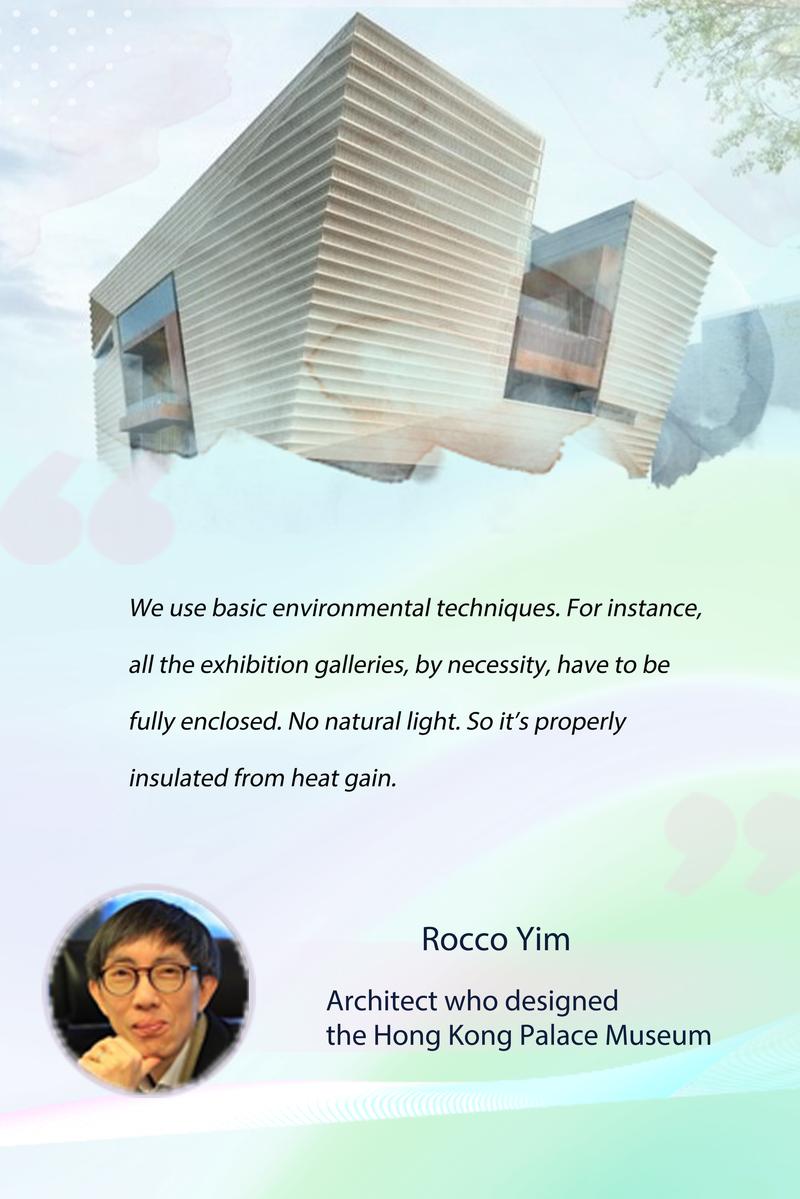
“We use basic environmental techniques. For instance, all the exhibition galleries, by necessity, have to be fully enclosed. No natural light,” says Yim. “So it’s properly insulated from heat gain.”
In contrast, the rest of the building allows optimum natural light to enter. And when a room faces west for instance, it will be protected by automatic blinds, Yim adds.
While controversies are part and parcel of large developments, the true measure of a museum’s eco-sensitivity lies in the way it handles the sustainable features created by the building designers. It will be interesting to watch how the HKPM fares in that department in the coming years.


